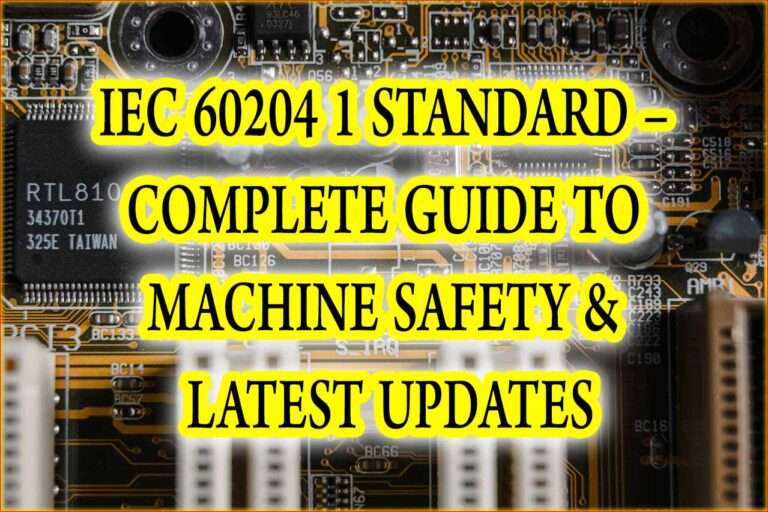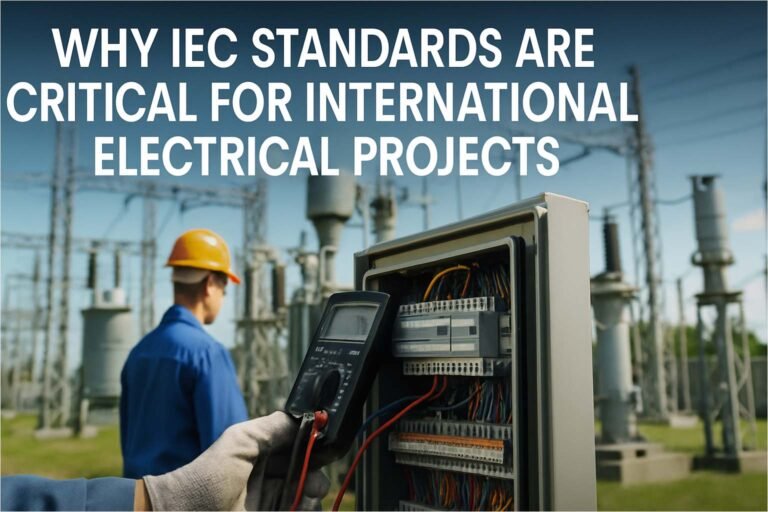IEC 61508 vs IEC 61511: Key Differences, Compliance Guide & Functional Safety Overview
Understanding industrial safety standards is essential for modern process plants. Two of the most important standards are IEC 61508 and IEC 61511. Many engineers and safety professionals often compare them to understand which one applies to their project. This detailed guide explains IEC 61508 vs IEC 61511 in simple language.
It covers the structure, requirements, safety lifecycle, SIL levels, and real-world use cases. The goal is to give you complete clarity on how both standards relate to each other and how they help improve functional safety in industrial systems.

Table of Contents
What Is IEC 61508 vs 61511?
The comparison of IEC 61508 vs 61511 starts with understanding the purpose of each standard. IEC 61508 is a generic functional safety standard. It applies to any industry that uses electrical, electronic, or programmable electronic safety-related systems. It sets the foundation for functional safety across all sectors. IEC 61511, on the other hand, is specifically developed for the process industry. It takes the principles of IEC 61508 and adapts them to chemical plants, oil and gas facilities, refineries, and other continuous process operations. Learn more about earthing cable size as per iec
Both standards aim to reduce risks to an acceptable level. They focus on Safety Integrity Levels, known as SIL. They also define a safety lifecycle approach. The difference is mainly in how they guide engineers in practical implementation.
Why IEC 61508 vs IEC 61511 Matters in Industrial Safety
Understanding IEC 61508 vs IEC 61511 is important because both standards influence design decisions and risk reduction strategies. Many process plants deal with hazards such as toxic gas leaks, high-pressure failures, fire, and explosion risks. A proper safety instrumented system is essential to handle these hazards. Using the right standard avoids design gaps and ensures compliance with international safety requirements. Discover everything about cable bending radius iec standard
IEC 61508 provides a broad framework. It guides manufacturers who develop safety PLCs, sensors, final control elements, and logic solvers. IEC 61511 guides plant owners and engineers who design and operate safety instrumented systems. So the choice between the two depends on your role in the safety lifecycle.
Key Differences Between IEC 61508 vs IEC 61511
The table below provides a clear comparison for quick reference.
Comparison Table: IEC 61508 vs IEC 61511
| Feature | IEC 61508 | IEC 61511 |
|---|---|---|
| Scope | Generic functional safety for all industries | Functional safety for process industry |
| Users | Manufacturers, system designers, product developers | Plant owners, operators, EPC contractors |
| Focus | Hardware and software development for safety devices | Design, operation, and maintenance of SIS |
| Safety Lifecycle | Broad and generic | Tailored for process operations |
| Certification | Product-level SIL certification | System-level SIL verification |
| Application | Applies to any sector (rail, nuclear, machinery, medical) | Specifically for continuous process operations |
This difference is key when selecting the right standard for your project. Explore details on iec 61508 functional safety
Safety Lifecycle in IEC 61508 vs IEC 61511
Both standards follow the safety lifecycle concept. It ensures safety is addressed from concept to decommissioning. The lifecycle helps engineers identify hazards, select safety functions, assign SIL, and maintain the system over time.
IEC 61508 focuses more on product development. It gives detailed guidance on hardware architecture, software reliability, and failure rates. It ensures the devices used in safety instrumented systems meet strict reliability requirements.
IEC 61511 focuses on system engineering. It guides users on how to build a safety instrumented system using certified components. It covers hazard analysis, SIL determination, installation, commissioning, and periodic proof testing. Understand better about nec 430.32
SIL Determination in IEC 61508 vs IEC 61511
Safety Integrity Levels are central to both standards. SIL levels range from SIL 1 to SIL 4. Higher levels mean higher reliability. The main difference is how each standard handles SIL calculations.
IEC 61508 gives detailed formulas and architectural constraints to determine SIL capability of devices. It applies fault tolerance requirements and hardware metrics. Manufacturers must demonstrate that their products meet these requirements.
IEC 61511 uses those certified devices and applies SIL at the system level. It focuses on risk reduction. It requires techniques such as Layers of Protection Analysis. It ensures the process plant achieves the target risk reduction for each safety function. Dive deeper into complete guide to iec 61508
SIL Comparison in IEC 61508 vs IEC 61511
| SIL Level | IEC 61508 Meaning | IEC 61511 Meaning |
|---|---|---|
| SIL 1 | Low integrity requirement | Basic risk reduction at plant level |
| SIL 2 | Moderate integrity | Common in process applications |
| SIL 3 | High integrity | High-risk areas like ESD systems |
| SIL 4 | Very high integrity | Rarely used in process industry |
Most process plants work with SIL 1 to SIL 3.
Real-World Applications of IEC 61508 vs IEC 61511
It helps to understand where these standards apply in practice. IEC 61508 applies when developing a safety product. For example, a company making safety PLCs must follow this standard. A manufacturer designing flame detectors, shutdown valves, and smart transmitters uses IEC 61508 to ensure functional safety.
IEC 61511 applies when using these devices in a plant. A refinery designing a high-integrity pressure protection system follows IEC 61511. A gas processing unit developing an emergency shutdown system follows this standard. It ensures that the plant meets safety requirements through design, operation, testing, and maintenance. Know more about iec 61508
Documentation Requirements in IEC 61508 vs IEC 61511
Both standards require strong documentation. But the type of documents differs. IEC 61508 requires documents such as hardware failure rate analysis, software verification reports, and architectural design reports. It mostly supports developmental evidence.
IEC 61511 requires operational documents such as hazard analysis reports, safety requirements specifications, proof test procedures, and maintenance plans. This ensures the system performs reliably throughout its lifetime.
Risk Reduction Approach in IEC 61508 vs IEC 61511
Both standards aim to reduce risk, but the style differs. IEC 61508 is quantitative. It uses failure rate numbers and detailed engineering calculations. IEC 61511 uses a mix of quantitative and qualitative approaches. It relies heavily on process knowledge and operational experience. This difference makes IEC 61511 more practical for plant operators. Use our online tool electricity load calculator in kw for home
Compliance Requirements in IEC 61508 vs IEC 61511
Compliance also differs. Many global manufacturers must obtain IEC 61508 certification for their products. This certification is issued by third-party authorities. It proves that a device meets the required Safety Integrity Level.
IEC 61511 does not certify devices. Instead, it guides the overall system. The plant must undergo audits, verifications, and functional safety assessments. These steps ensure that the safety instrumented system meets the defined performance targets.
Which Standard Should You Use?
The choice between IEC 61508 vs 61511 depends on your role. If you manufacture safety-related devices, IEC 61508 applies. If you operate or design a process plant, IEC 61511 is the right standard. Most real-world safety instrumented systems are a mix of both. Devices are certified under IEC 61508, while the system is engineered under IEC 61511. This combination ensures strong functional safety from design to operation. Uncover insights on iec standard for lighting lux level
Future of IEC 61508 vs IEC 61511 in Functional Safety
Functional safety is evolving with digital transformation, smart sensors, and advanced diagnostics. Both standards continue to adapt. IEC 61511 is becoming more focused on cybersecurity because modern plants are connected systems. IEC 61508 is updating hardware reliability models due to new semiconductor technologies. Understanding the latest revisions helps engineers ensure compliance and strong system performance.
Final Thoughts
Understanding IEC 61508 vs 61511 is essential for anyone involved in functional safety. Both standards work together to reduce risks in industrial systems. IEC 61508 provides the foundation. IEC 61511 applies that foundation in process plants. When used correctly, they ensure reliable safety instrumented systems, improved plant uptime, and lower accident risks. Read in detail about iec 61439 busbar calculation
Follow Us on Social:
Subscribe our Newsletter on Electrical Insights to get the latest updates in Electrical Engineering.
#IEC61508vs61511, #IEC61508, #IEC61511, #FunctionalSafety, #ProcessSafety, #SILCertification, #SafetyIntegrityLevel, #IndustrialSafetyStandards, #SafetyCompliance, #SafetyLifecycle, #RiskAssessment, #InstrumentationSafety, #SafetySystemDesign, #SafetyEngineering, #SafetyStandards





